Persian Inscriptions on Indian Monuments
Persian Inscriptions on Indian Monuments is a book written in Persian by Dr Ali Asghar Hekmat E Shirazi and published in 1956 and 1958 and 2013. new edition contains the Persian texts of more than 200 epigraphical inscriptions found on historical monuments in India, many of which are currently listed as national heritage sites or registered as UNESCO world heritage . The most recent edition, containing an additional 200 epigraphical inscriptions from Indian monuments, has been published in Persian; an English edition is also being printed.[1] [2]
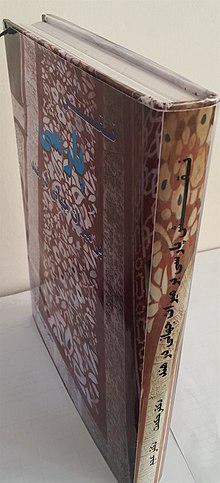 Cover page for | |
| Author | Dr Ali Asghar Hekmat E Shirazi and Dr.Ajam |
|---|---|
| Original title | نقش پارسی بر احجار هند |
| Illustrator | Dr.Ajam |
| Cover artist | Dr.Ajam |
| Language | Persian -English |
| Subject | Persian Inscriptions on the Indian Monuments |
| Published | 1956-1958-2013 |
| Publisher | New Delhi, Tehran university |
Publication date | 1956- 1958 - 2013 |
| Text | [[s:Parssea |]] at Wikisource |
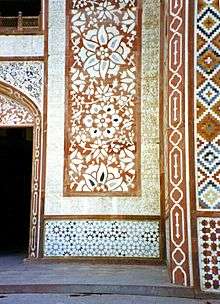
Third edition
After being forgotten for over 50 years, a third edition of the book has been printed by Dr. Mohammad Ajam. the absence of the book was felt particularly by students of the Persian language and literature, as well as linguistics. The new edition includes images of many of the inscriptions it describes, as well as a new seventh chapter consisting of five parts. The new edition of the book has been published under a different title: Persian Inscriptions on the Indian World Heritage Sites. because many of the stone inscriptions it describes have been preserved and registered as world heritage The new edition contains more than 120 images.
Book contents
In India, Persian inscriptions are usually found on buildings such as mosques and tombs, or on secular edifices including forts, palaces, gateways, water tanks, wells, gardens and bridges. Certain movable objects such as seals, signets, vases and eating utensils often bear inscriptions too. Most pre-Mughal Indian Islamic and Persian inscriptions in India date from the last decade of the 12th century AD, when Muhammad Ghori (Guri) conquered Delhi and established his sultanate there. However, a small number of inscriptions have been found in Haryana, Gujarat and Kerala which bear earlier dates.
In Persian, Arabic and (more recently) Urdu inscriptions found in India, the dynasties represented most prominently are the Mamluks, the Khaljis, the Tughluqs, the Sayyids, the Lodis, the Mughals and Surs (in the center). Many other regional dynasties also receive prominent representation in inscriptions within India. When the powerful Mughals and (khorasanid) dynasties assumed power, they used Persian as the main language for all academic and administrative matters, including inscriptions, coins, official letters and many others. Under the later Mughals, many of the regional principalities became autonomous and continued using Persian as their official language. Later, when Urdu came into wider use, its existence was also recorded in inscriptions.
In addition to Arabic, Persian and Urdu inscriptions, there are also bilingual and even trilingual inscriptions (for example, in Arabic combined with regional languages such as Gujarati, Bengali, Tamil and Malayalam, or Persian combined with provincial languages such as Kannada, Telugu, Oriya, Tamil, Gujarati and Marathi). Persian and mixed Quranic Arabic with Persian have been used alongside many other languages, including Sanskrit, Hindi, English, Portuguese and many others. Examples of such inscriptions can be found in Qutb Minar at New Delhi, the Tomb of Akbar the Great at Sikandara, the Adina Mosque at Pandua (Bengal), the Taj Mahal at Agra and many other locations. In addition, Arabic and Persian inscriptions can be found written in various different popular scripts or styles of Islamic Persian Calligraphy, including Kufi, Naskh, Thuluth, Riqa and Nastaliq.[3] The book describes many palaces, forts, tombs and mosques inscribed with Persian Inscriptions.
.jpg)
Mughal dynasty or Mughal Persian dynasty who originally came from great Khorasan and are known in Iran and Afghanistan as the Gourkanid dynasty also had link to (Ghurid dynasty). Mughal Persian dynasty begins with Babur a Persian word means Tiger. His grandson Akbar developed Indo-Persian culture and the Mughal architecture style developed vigorously during his reign. Among his accomplishments were Agra Fort, the fort-city of Fatehpur Sikri, and the Buland Darwaza. Akbar's son Jahangir commissioned the Shalimar Gardens in Kashmir and Humayun's Tomb.
- Indo-Persian culture reached its zenith during the reign of Shah Jahan, who constructed Taj Mahal, the Jama Masjid, the Shalimar Gardens of Lahore, the Wazir Khan Mosque, and who renovated the Lahore Fort. The last of the great Mughal architects was Aurangzeb, who built the Badshahi Mosque.
First chapter
The first chapter of the book is dedicated to the history of Persian inscription in India, describing the history of epigraphy up to the initial development of Islam and beyond. Sassanid Persian inscriptions can be found in the Ajanta cave, on many coins dating from the reign of Pulakesin II and on the crosses of churches such as St. Thomas Mount and San Thome Basilica in Chennai and St. Mary's Orthodox Valiyapally in Bangalore. .[4]

Palaces, citadels
The book describes Persian Inscriptions on many palaces and fort in India including:
- Red castle or The Red Fort is a historic fort in the city of Delhi that served as the main residence of the Mughal Emperors. Emperor Shah Jahan commissioned construction of the Red Fort on 12 May 1638, when he decided to shift his capital from Agra to Delhi. Originally red and white, Shah Jahan's favourite colours, its design is credited to architect Ustad Ahmad Lahori, who also constructed the Taj Mahal. It was constructed between May 1639 and April 1648.it was conquered by Nader shah of Persia.
- in the Rashtrapati Bhavan and the buildings in this complex there are many persian inscriptions especialy in the hall of Ashoka (former Persika). is the official residence of the President of India in New Delhi, Rashtrapati Bhavan may refer to only the 340-room main building that has the president's official residence, including reception halls, guest rooms and offices, also called the mansion; it may also refer to the entire 130-hectare (320 acre) Presidential Estate that additionally includes huge presidential gardens (Mughal Gardens), large open spaces, residences of bodyguards and staff, stables, other offices and utilities within its perimeter walls. In terms of area, it is the largest residence of any head of state in the world.[5]
Mausoleums
The book describes 47 Mausoleum and tombs in India inscribed with Persian Inscriptions.
- Mausoleum of Akbar or Akbar's tomb is the tomb of the Mughal emperor Akbar. This tomb is an important Mughal architectural masterpiece. It was built in 1605–1613 by his son Jahangir and is situated in 119 acres of grounds in Sikandra, a sub of Agra, the best marble stone inscribed with Persian Inscriptions and poem.

Persian inscription in the mosques
The book had described Persian inscription in the 14 mosques in India including:
- The Jama Masjid, Delhi of Delhi, is one of the largest mosques in India. It was built by the Mughal Emperor Shah Jahan between 1650 and 1656 The mosque was completed in 1656 AD with three great gates and two 40 metres high minarets constructed with strips of red sandstone and white marble. The courtyard can accommodate more than 25000 people. There are three domes on the terrace which are surrounded by the two minarets. The architectural plan of Badshahi Masjid, built by Shah Jahan's son Aurangzeb at Lahore, Pakistan, is similar to the Jama Masjid.
.[6] Shah Jahan also built the Taj Mahal, at Agra and the Red Fort in Old Delhi, which stands opposite the Jama Masjid.it remained the royal mosque of the emperors until the end of the Mughal period.[7]
- Jamia Masjid is a mosque in Srinagar, Jammu and Kashmir, India. Situated at Nowhatta in the middle of the Old City, the Mosque was commissioned by Sultan Sikandar in 1394 CE and completed in 1402 CE,[8] at the behest of Mir Mohammad Hamadani, son of Mir Sayyid Ali Hamadani,[9] and is regarded as one of the most important mosques in Kashmir.The Mosque is located in Downtown which remains a central zone to the religio-political life in Srinagar. Thronged by Muslims every Friday, it is one of the prime tourist attractions of Srinagar.[10]
- Babri Masjid meaning Mosque of Babur (Tiger) was a mosque in Ayodhya, India at a site believed by Hindus to be the birthplace of Hindu deity Rama.

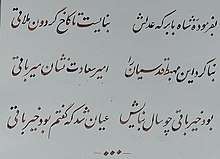

,
Akbar works to develop Indo-Persian culture
- Agra Fort Agra fort is a UNESCO world heritage site in Agra, Uttar Pradesh. Jahangiri Mahal and Humayun's Tomb Humayun’s Tomb, is often regarded as the first mature example of Mughal architecture.
- Fatehpur Sikri,
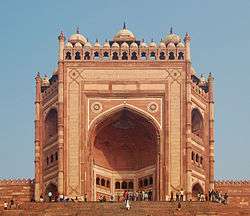 Buland Darwaza, Agra was built by Akbar the Great to commemorate his victory.
Buland Darwaza, Agra was built by Akbar the Great to commemorate his victory.
The main religious buildings were the huge Jama Masjid and small Tomb of Salim Chisti. Buland Darwaza, also known as the Gate of Magnificence, was built by Akbar in 1576 to commemorate his victory over Gujarat and the Deccan. The Tomb of Salim Chishti is famed as one of the finest examples of Mughal architecture in India, built during the years 1580 and 1581.
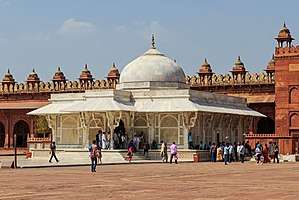
The Begum Shahi Mosque is an early 17th-century mosque situated in the Walled City of Lahore, Pakistan.
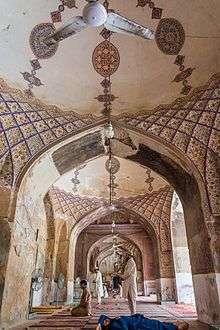
- Tomb of I'timād-ud-Daulah*
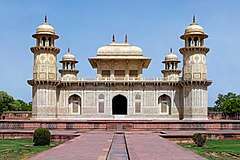 The tomb of I'timād-ud-Daulah is often regarded as a draft of the Tāj Mahal.
The tomb of I'timād-ud-Daulah is often regarded as a draft of the Tāj Mahal.
The tomb of I'timād-ud-Daulahmausoleum in the city of Agra in the Indian state of Uttar Pradesh. the tomb of I'timād-ud-Daulah is often regarded as a draft of the Taj Mahal.Shahi Bridge, Jaunpur was also constructed during the reign of the Mughal Emperor Akbar.
Shah Jahan

The Wazir Khan Mosque in Lahore was commissioned during the reign of Shah Jahan, his reign at Agra, Delhi and Lahore. Some examples include the Taj Mahal at Agra, the tomb of his wife Mumtaz Mahal. The Moti Masjid (Pearl Mosque) in the Lahore Fort and the Jama Masjid at Delhi are imposing buildings of his era, Shah Jahan also built sections of the Sheesh Mahal, and Naulakha pavilion, also in Thatta called Shahjahan Mosque. Shah Jahan also built the Red Fort in his new capital at Shah Jahanabad, now Delhi. The red sandstone Red Fort is noted for its special buildings-Diwan-i-Aam and Diwan-i-Khas.
- Taj Mahal* The Taj Mahal, a World Heritage Site was built between 1630–49
- Wazir Khan Mosque
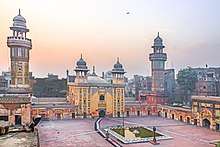
The Wazir Khan Mosque was commissioned during the reign of the Mughal Emperor Shah Jahan in 1634, and completed in 1642
- Shalimar Gardens
- The Shah Jahan Mosque is the central mosque for the city of Thatta, in the Pakistani province of Sindh.
- Shahi Hammam is a Persian-style bath which was built in Lahore, Pakistan, in 1635 C.E. during the reign of Emperor Shah Jahan.

In Aurangzeb's reign (1658–1707)
The Badshahi Mosque in Lahore, Pakistan was commissioned by the sixth Mughal Emperor Aurangzeb.
Additional monuments with Persian Mughal structure
Zinat al-Masjid in Daryaganj was overseen by Aurangzeb's second daughter Zinat-al-Nissa. Aurangzeb's sister Roshan-Ara who died in 1671. The tomb of Roshanara Begum

Lalbagh Fort (also known as "Fort Aurangabad"), Dhaka, Bangladesh, whose construction started in 1678 during the reign of Aurangzeb’s son Azam Shah.
- Sunehri Mosque [[File:Sunehri_masjid_top_view_2.JPG|thumb|The 18th
Sunehri Mosque was built in 1753 when the empire was in decline, during the reign of Muhammad Shah.
- Tomb of Safdar Jang The Tomb of Safdar Jung completed in 1754 is one of the last examples of Mughal Architecture.
Mughal gardens This style was influenced by Persian gardens. Humayun's Tomb, was the first sample of later Mughal gardens.
First part of the Third edition
The first part from the new edition chapter added in 2013 contains a selection of Persian inscriptions found on the Hyderabad Monuments, dating from the time of the Qutb Shahi dynasty. It also contains inscriptions from the Golkonda fort and the Deccan in the Andhra Pradesh.
Second part of the new edition
The second part contains details of Persian epigraphy on Bengal stones.
Third part
The third part deals with the Mughal/Persian architecture in India. The influence Persian-style architecture and language in India began with the Tughlaq dynasty; in addition, all the ruling dynasties after them were originally from Greater Khorasan, an area dominated by Persian language and culture. The Mughal dynasty also came from Greater Khorasan, which is why the book describes Mughal architecture as the Khorasanid or Persian style of architecture.[4]
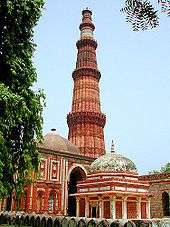
Mughal tombs, made from sandstone and marble, emphasise the Persian influence.[11] Among the architectural achievements of this era are the Red Fort at Agra (1565–74) and the walled city of Fatehpur Sikri (1569–74), as well as the Taj Mahal, which was built as a tomb for Queen Mumtaz Mahal by Shah Jahan (1628–58).[11] With its double dome, its recessed archway, its white marble and its parks, as well as the emphasis on symmetry and detail, this building contains many of the key elements of architecture from the period of Shah Jahan.[12] Verses from the Quran were inscribed on the walls of the buildings; problematically, though the depiction of living beings (which was an essential part of the pre-Islamic artistic tradition of India) is forbidden by the Islamic religion.[11][13]
Fourth part
The fourth part describes the Persian language and its influence over other languages such as Hindi, Urdu and Turkic.
Fifth part
The fifth part contains some samples of royal orders, including government instructions, and copies of the Persian drawings found in the museums of Hyderabad and Delhi.
Indian monuments with Persian inscriptions
According to the book Persian Inscriptions on Indian Monuments, there are nearly 15,000 examples of Persian and Quranic inscriptions in India, mostly found in cities such as Hyderabad, Delhi, Agra and Lucknow, amongst others. The list of historical Indian monuments containing Persian inscriptions and Persian calligraphy includes the following:
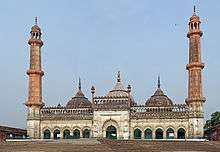
- The Qutub Minar
- The Red Fort
- Humayun's Tomb
- Akbar's tomb
- Rashtrapati Bhavan
- The Lodhi Gardens
- Purana Quila
- Safdarjung's Tomb
- Qutb complex
- Mehrauli in South Delhi.
Mehrauli was built by Qutub-ud-din Aibak and heralded the beginning of a new style of art and architecture which came to be known as the Indo-Islamic style. Other monuments included in the Qutub complex are the Jamali Kamali Mosque and Tomb, Balban's tomb, Quli Khan's Tomb, Rajon Ki Baoli in Mehrauli Archaeological Park. In addition, Jahaz Mahal and Adham Khan's Tomb are located on a hilltop nearby.
Other monuments with Persian inscriptions include the following:
- Tughlaqabad
- Bedil Dehlavi
- Amir Khusrow Dehlavi
- Lucknow
- St. James' Church
- Bara Imambara
- Buland Darwaza
- Lahore Fort
- Taj Mahal
- Bibi Ka Maqbara
- Fatehpur Sikri
- Moinuddin Chishti
- Badshahi Masjid
- Ataga Khan
Gallery
Pictures of some of the Indian monuments which contain Persian inscriptions and have been explained in the book: more pictures in flicker
 The Taj Mahal.
The Taj Mahal.
- Jama Masjid, Delhi
- The ruins of the Golconda Fort
- Golconda Fort, Hyderabad
 The Tomb of Akbar the Great,
The Tomb of Akbar the Great, Asfi Mosque, Imambara, Lucknow
Asfi Mosque, Imambara, Lucknow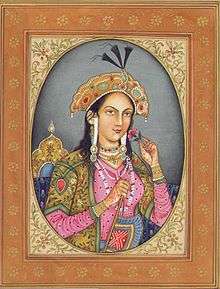 Mumtaz Mahal
Mumtaz Mahal
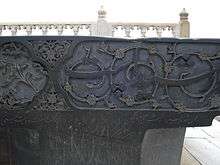 Calligraphy of several 18th-century Persian poems.
Calligraphy of several 18th-century Persian poems.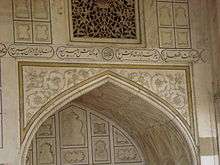 A Persian poem.
A Persian poem. A Persian poem.
A Persian poem.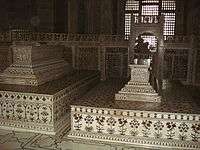 Arjomand Banou
Arjomand Banou- The Jama Masjid is the principal mosque of Old Delhi.
 At 72.5m tall, the 13th-century Qutub Minar is the world's tallest brick minaret.
At 72.5m tall, the 13th-century Qutub Minar is the world's tallest brick minaret. The Red Fort is the site from which the Prime Minister of India addresses the nation on Independence Day.
The Red Fort is the site from which the Prime Minister of India addresses the nation on Independence Day.
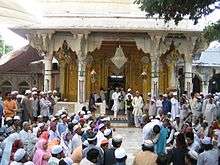 The dargah of Moinuddin Chishti, Ajmer.
The dargah of Moinuddin Chishti, Ajmer.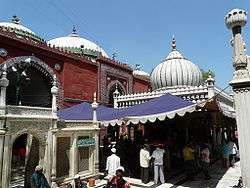
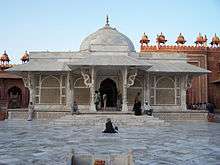 The Tomb of Salim Chisti at Fatehpur Sikri near Agra.
The Tomb of Salim Chisti at Fatehpur Sikri near Agra.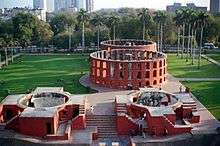 Jantar Mantar consists of 13 architectural and astronomical instruments, built by Maharaja Jai Singh II between 1727 and 1734.
Jantar Mantar consists of 13 architectural and astronomical instruments, built by Maharaja Jai Singh II between 1727 and 1734.- The Mausoleum of Ghiyath al-Din Tughluq at Tughlaqabad Fort.
- Humayun's Tomb is one of Delhi's most famous landmarks. This monument has an architectural design similar to the Taj Mahal.
- This mausoleum in the Lodhi Gardens is known as the Shisha Gumbad (glass dome) because of its internal glass decorations.
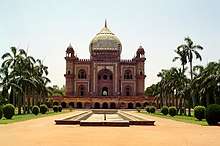 Safdarjung's Tomb is a garden tomb within a marble mausoleum.
Safdarjung's Tomb is a garden tomb within a marble mausoleum.- The Bara Gumbad and Bara Gumbad Mosque in the Lodhi Gardens.
 Sher Mandal in Purana Qila stands on an ancient mound. Excavations near its eastern wall reveal that the site has been continuously occupied since 1000 BC.
Sher Mandal in Purana Qila stands on an ancient mound. Excavations near its eastern wall reveal that the site has been continuously occupied since 1000 BC.
.jpg) Facade of Taj Mahal Quranic verses with Persian (4718894898)
Facade of Taj Mahal Quranic verses with Persian (4718894898) Humayun’s Tomb, Delhi, India
Humayun’s Tomb, Delhi, India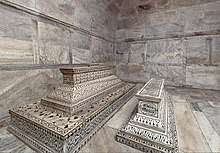 Tombs- Quranic verses with Persian calligraphy
Tombs- Quranic verses with Persian calligraphy Taj Mahal Mosque, Agra
Taj Mahal Mosque, Agra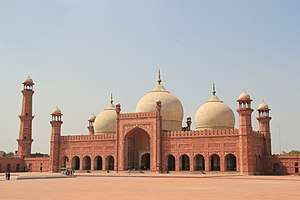 Badshahi Mosque front picture
Badshahi Mosque front picture Fatehput Sikiri Buland Darwaza gate 2010
Fatehput Sikiri Buland Darwaza gate 2010 Agra darvaze Taj Mahal Quranic verses with Persian calligraphy style
Agra darvaze Taj Mahal Quranic verses with Persian calligraphy style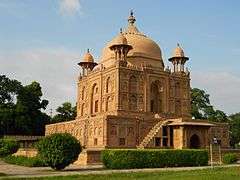 Tomb of Nisar Begum at Khusro Bagh Allahabad
Tomb of Nisar Begum at Khusro Bagh Allahabad Grave of Emperor Jahangir II Pakistan Quranic verses with Persian calligraphy style
Grave of Emperor Jahangir II Pakistan Quranic verses with Persian calligraphy style The Darwaza-i-Rauza (Great Gate) of the Taj Mahal.
The Darwaza-i-Rauza (Great Gate) of the Taj Mahal.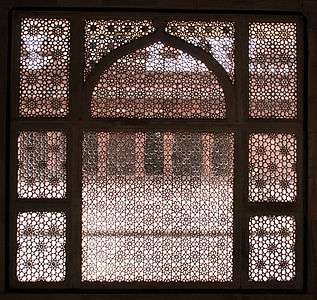
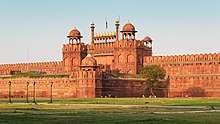
 Jahangir's grave at the Tomb of Jahangir, decorated with parchin kari work.
Jahangir's grave at the Tomb of Jahangir, decorated with parchin kari work. Tomb of Nithar Begum at Khusro Bagh, Allahabad, India.
Tomb of Nithar Begum at Khusro Bagh, Allahabad, India.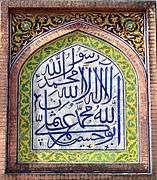

- Diwan-i-Khas (Hall of private audience) at Lahore Fort.
.jpg)
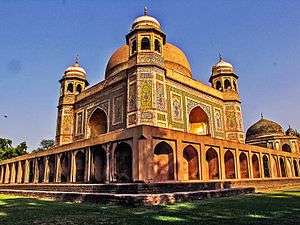 One of the Tombs of Ustad-Shagird, Nakodar, India.
One of the Tombs of Ustad-Shagird, Nakodar, India.- An unknown Lodi tomb in Akbar's Tomb complex
- Barrel vault
- Front Façade
- Circumferential Gallery around the cenotaph
- View of South Gate from Interior
 Main entrance of Akbar's Tomb complex from inside.
Main entrance of Akbar's Tomb complex from inside. Tomb ceiling details, Tomb of Akbar, Sikandra
Tomb ceiling details, Tomb of Akbar, Sikandra Calligraphy over the entrance to the main burial chamber.
Calligraphy over the entrance to the main burial chamber. True tomb of Akbar, at the basement of the tomb.
True tomb of Akbar, at the basement of the tomb.- Kanch Mahal, built by Jehangir, as a harem quarter later used as a hunting lodge.
 Inside work of Akbar's tomb
Inside work of Akbar's tomb_of_main_Cenotaph.jpg) Entrance Arch (inside details) of main Cenotaph
Entrance Arch (inside details) of main Cenotaph Akbar's Tomb at basement
Akbar's Tomb at basement- Dewan-e-Khas (Hall of Special Audience pakistan)
.jpg) Shah Jahan Mosque Center (20673302596)
Shah Jahan Mosque Center (20673302596) persian poem
persian poem a replica frome the Baberi Mosque inscription
a replica frome the Baberi Mosque inscription Rashtrapati Bhavan is the presidential palace.
Rashtrapati Bhavan is the presidential palace.
See also
- Indo-Persian culture
- Mughal architecture
- Indo-Islamic architecture
- Tomb of Akbar the Great
- Red Fort
- Buland Darwaza
- Fatehpur Sikri
- Lahore Fort
- Taj Mahal
- Jama Masjid
- Bibi Ka Maqbara
- Lucknow
- Khanzada
- Ata Hussain Fani Chishti
- Chishti
- Indo-Persian culture
- Khwaja Maudood Chishti
- Khwaja Wali Kirani
- Moinuddin Chishti
- Jahangir
- Asaf Khan
- Achabal Gardens
- Mughal Empire
- Nurmahal
- Nur Jahan
- Persian language in South Asia
- List of Persian calligraphers
- Bara Imambara
- Chhota Imambara
- Imambara Ghufran Ma'ab
- Shah Najaf Imambara
- Documents on the Persian Gulf's name
| Part of a series on Islam Sufism |
|---|
|
List of sufis |
|
|
References
- Iran, India relations span centuries marked by meaningful interactions Dr.Mohammad Ajam
- Persian Inscriptions on Indian Monuments Dr.Mohammad Ajam
- Persian Inscriptions on Indian Monuments Dr.Mohammad Ajam
- Ajam, Mohammad (29 April 2013). "Persian Inscriptions on the Indian Monuments". parssea. Retrieved 15 June 2020.

- "Making of Rashtrapati Bhavan". Retrieved 2019-05-26.
- "Jama Masjid, Delhi". Cultural India website. Retrieved 19 May 2017.
- Persian Inscriptions on Jamamasjid by Dr.Mohammad Ajam
- "Jama Masjid Srinagar - Biggest Mosque in Kashmir Valley". Tour My India. Tour My India Pvt. Ltd. Retrieved 9 January 2019.
- "Jamia Masjid Srinagar". Gaffara Kashmir. Archived from the original on 21 July 2017. Retrieved 2009-05-08.
- Persian Inscriptions on Mosque Srinagar IRNA,photo from the book
- Encyclopædia Britannica (2008), Mughal architecture.
- Encyclopædia Britannica (2008), Shāh Jahān period architecture.
- Rezavi, Syed Ali Nadeem (2002). Iranian Influence on Medieval Indian Architecture, The Growth of Civilizations in India and Iran. Tulika.
External links
Persian Inscriptions on Indian heritage Monuments by Dr. Ajam.
- Nur Jahan: Empress of Mughal India, by Ellison Banks Findly, Oxford University Press US. 2000. ISBN 0-19-507488-2.excerpts online
- Persian Inscriptions on Indian Monuments[]
- Why is Persian dying out in India, despite its deep roots?Most Persian manuscripts lie unused and locked in Indian libraries and archives.
- Brief history of Persian Calligraphy
- About history of Persian Calligraphy and its different styles
Iran India relations span centuries marked by meaningful interactions by Dr. Ajam.
- Nur Jahan: Empress of Mughal India, by Ellison Banks Findly, Oxford University Press US. 2000. ISBN 0-19-507488-2.excerpts online
Persian Inscriptions on Indian MonumentsPersian Inscriptions on Indian Monuments Dr.Mohammad Ajam
.jpg)